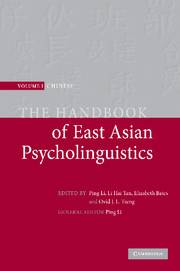Book contents
- Frontmatter
- Contents
- List of figures
- Notes on contributors
- Preface
- Introduction: new frontiers in Chinese psycholinguistics
- Part I Language acquisition
- 1 Actions and results in the acquisition of Cantonese verbs
- 2 Chinese children's knowledge of the Binding Principles
- 3 Chinese classifiers: their use and acquisition
- 4 Child language acquisition of temporality in Mandarin Chinese
- 5 Second language acquisition by native Chinese speakers
- 6 Making explicit children's implicit epilanguage in learning to read Chinese
- 7 Emergent literacy skills in Chinese
- 8 Basic syntactic categories in early language development
- 9 Growth of orthography-phonology knowledge in the Chinese writing system
- 10 Interaction of biological and environmental factors in phonological learning
- 11 The importance of verbs in Chinese
- 12 Grammar acquisition via parameter setting
- 13 Early bilingual acquisition in the Chinese context
- Part II Language processing
- Part III Language and the brain
- Epilogue: a tribute to Elizabeth Bates
- References
- Name index
- Subject index
12 - Grammar acquisition via parameter setting
Published online by Cambridge University Press: 05 June 2012
- Frontmatter
- Contents
- List of figures
- Notes on contributors
- Preface
- Introduction: new frontiers in Chinese psycholinguistics
- Part I Language acquisition
- 1 Actions and results in the acquisition of Cantonese verbs
- 2 Chinese children's knowledge of the Binding Principles
- 3 Chinese classifiers: their use and acquisition
- 4 Child language acquisition of temporality in Mandarin Chinese
- 5 Second language acquisition by native Chinese speakers
- 6 Making explicit children's implicit epilanguage in learning to read Chinese
- 7 Emergent literacy skills in Chinese
- 8 Basic syntactic categories in early language development
- 9 Growth of orthography-phonology knowledge in the Chinese writing system
- 10 Interaction of biological and environmental factors in phonological learning
- 11 The importance of verbs in Chinese
- 12 Grammar acquisition via parameter setting
- 13 Early bilingual acquisition in the Chinese context
- Part II Language processing
- Part III Language and the brain
- Epilogue: a tribute to Elizabeth Bates
- References
- Name index
- Subject index
Summary
Introduction
Chomsky's Principles and Parameters (P&P) framework (1981) is an alternative to the earlier generative grammar that made use of phrase structure rules (Chomsky, 1957, 1965). This shift of paradigm was motivated by two independent lines of evidence. First, as more and more languages were subjected to generative studies, a number of universal principles emerged, ones which are not restricted to specific constructions or particular languages. Second, a great variety of sentence structures can be efficiently described by a small number of parameters; different grammars are instantiations of different operational choices in a universal engine of sentence building, much like configuring computer software.
The P&P framework, like its phrase structure predecessor, offers an important perspective on children's acquisition of grammar. The principles, which are putatively innate and universal, are not learned, and can be expected to be operative in (early) child language; this opens up a wealth of topics for empirical research. On the other hand, the parameter values, which vary crosslinguistically, must be learned on the basis of specific linguistic evidence, which also can be quantified and evaluated empirically. Thus, the commonalities and differences in children's acquisition of specific languages receive a principled and unified interpretation. Moreover, if the number of parameters is finite, then there is only a finite – albeit large, perhaps – number of grammars that forms the child's learning space; this sidesteps the well-known problem of inductive indeterminacy in an infinite hypothesis space associated with phrase structure rules (Gold, 1967; Chomsky, 1981).
- Type
- Chapter
- Information
- The Handbook of East Asian Psycholinguistics , pp. 136 - 147Publisher: Cambridge University PressPrint publication year: 2006
- 1
- Cited by



